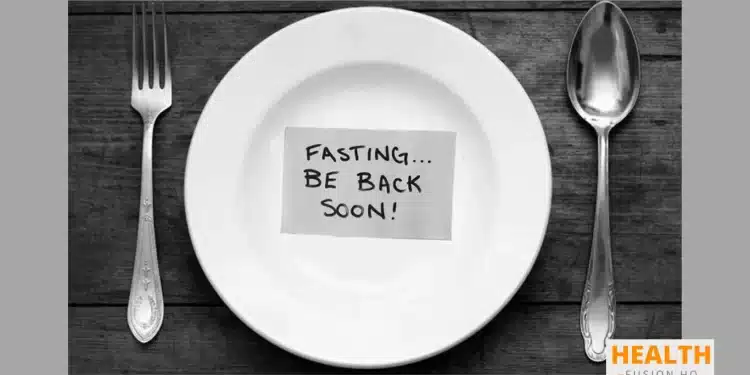Intermittent fasting for beginners – Have you ever heard of the phrase “you are what you eat”? Well, with intermittent fasting, it’s more like “you are what you don’t eat.” Intermittent fasting is a method of dieting where you cycle between periods of eating and fasting. The idea is to give your body a break from constantly digesting food and allow it to use its stored energy instead.
Now, you might be wondering why anyone would want to try intermittent fasting.
Well, there are a lot of potential benefits, including weight loss, improved metabolism, and even reduced risk of diseases like diabetes and cancer. But before diving into this fasting routine, it’s important to understand the basics and the various types of intermittent fasting. This way, you can make an informed decision and achieve the best results for your body.
| Key Takeaways |
| Intermittent Fasting is a method of eating that involves periods of fasting and eating within a specific time frame. |
| There are different types of Intermittent Fasting, and each has its own set of guidelines to follow. |
| The duration of Intermittent Fasting should be determined based on individual factors such as health status, lifestyle, and goals. |
| Daily Intermittent Fasting can be safe and effective, but it’s important to listen to your body and adjust accordingly. |
| Long-term Intermittent Fasting can have both benefits and risks, and it’s important to consult a healthcare professional before starting. |
| The first rule of Intermittent Fasting is to start slowly and gradually increase the duration of fasting. |
| Starting Intermittent Fasting can be challenging, but there are various strategies and tools to help you stay on track. |
| After three days of Intermittent Fasting, the body undergoes several changes, including increased fat-burning and cellular repair. |
| The frequency of Intermittent Fasting should be determined based on individual factors, and there are alternatives to daily fasting. |
Intermittent Fasting Basics
Now that we have a basic understanding of what intermittent fasting is, let’s dive into the details. In this section, we will explore the definition of intermittent fasting, how it works, and the benefits that come with this eating pattern. By the end of this section, you will have a comprehensive understanding of the fundamentals of intermittent fasting and why it has become a popular trend in the health and wellness industry. So, let’s get started!
Definition of Intermittent Fasting
Intermittent fasting is a relatively simple approach to eating that involves restricting the periods during which you consume food. Essentially, it’s a pattern of eating that alternates between periods of eating and periods of not eating. The periods of fasting can vary in length, but they typically range from 16 to 24 hours.
During the eating periods, it’s important to consume healthy, nutrient-dense foods to ensure your body is getting the necessary nutrients it needs. This type of eating pattern is not a diet in the traditional sense, but rather a lifestyle choice that can have numerous health benefits when done correctly. It’s important to note that intermittent fasting should be done under the guidance of a healthcare professional to ensure it’s safe and effective for each individual’s unique needs.
How Intermittent Fasting Works
Intermittent fasting works by shifting your body’s energy source from glucose (sugar) to fat. During a fast, your body burns stored fat for energy, which can help you lose weight.
This process is called ketosis, and it can also have other health benefits, such as reducing inflammation and improving blood sugar levels. By restricting the time frame in which you eat, intermittent fasting can help you achieve these benefits without having to completely overhaul your diet.
Overview of the Benefits of Intermittent Fasting
Intermittent fasting is more than just a weight loss technique; it has numerous health benefits that make it an attractive option for many people. One of the most significant benefits of intermittent fasting is weight loss, as it helps reduce calorie intake and increase metabolism. Additionally, it can help improve blood sugar control, which is important for individuals with type 2 diabetes or insulin resistance.
Moreover, intermittent fasting has been shown to have positive effects on heart health by reducing blood pressure, cholesterol levels, and inflammation. It may also improve brain function, such as increased mental clarity and reduced risk of neurological disorders like Alzheimer’s disease.
Lastly, studies suggest that intermittent fasting can even increase longevity and promote healthy aging by protecting against age-related diseases and promoting cellular repair. Overall, intermittent fasting can be a powerful tool for improving various aspects of health and well-being.
Getting Started with Intermittent Fasting
Are you interested in trying out intermittent fasting? Before you start, it’s important to understand the basics and consider a few factors. In this section, we’ll go over six things to consider before trying intermittent fasting, provide expert tips on how to get started, discuss the best types of intermittent fasting for beginners, explain the rule of intermittent fasting, and outline steps for starting a fasting routine. By the end of this section, you’ll have all the information you need to start your journey with intermittent fasting.
You can find more details watching the following video here.
6 Things to Consider Before Trying Intermittent Fasting
- Speak with a healthcare professional before starting intermittent fasting, especially if you have a medical condition or take medications.
- Understand the different types of intermittent fasting and choose one that suits your lifestyle and preferences.
- Start slowly and gradually increase fasting periods to avoid negative side effects.
- Stay hydrated and consume nutritious foods during eating periods.
- Monitor your hunger levels and stop fasting if you feel excessively hungry or unwell.
- Listen to your body and adjust your fasting routine as needed.
Expert Tips for Intermittent Fasting For Beginners On How To Get Started
- Start with a shorter fasting period, such as 12-14 hours, and gradually increase to longer periods.
- Schedule your eating periods around your daily routine and try to stick to a consistent schedule.
- Keep yourself busy during fasting periods to avoid excessive hunger or boredom.
- Experiment with different types of foods during eating periods to find what works best for you.
- Don’t be too hard on yourself if you slip up – intermittent fasting is not an all-or-nothing approach.

Best Types of Intermittent Fasting for Beginners
When it comes to choosing the best type of intermittent fasting for beginners, it’s important to consider your lifestyle, schedule, and eating habits. Time-restricted feeding, also known as TRF, is a popular and effective approach for those who are new to intermittent fasting.
This method involves limiting your eating window to a specific number of hours each day, typically between 8 to 10 hours, and fasting for the remaining hours. For instance, the 16:8 method involves fasting for 16 hours and eating during an 8-hour window. This is a great option for beginners because it allows you to ease into the fasting routine gradually, without feeling too deprived or hungry.
Additionally, TRF is flexible and can be easily adapted to fit your daily routine, making it easier to maintain over time. As you become more comfortable with TRF, you may consider trying other types of intermittent fasting, such as alternate-day fasting or modified fasting.
Intermittent Fasting for Beginners Follow a Simple Rule
You alternate between eating and fasting periods. During fasting periods, you should not consume any food, but you are allowed to have non-caloric beverages such as water, tea, and coffee.
These beverages will help keep you hydrated and suppress your appetite. The length of the fasting period can vary depending on the type of intermittent fasting you choose, but most beginners start with a 16:8 or 14:10 time-restricted feeding schedule. It’s essential to stick to the rule of intermittent fasting to achieve the best results.
Steps For Starting a Fasting Routine
- Choose a type of intermittent fasting that suits your lifestyle and preferences.
- Gradually increase fasting periods and start with a shorter fast if you are a beginner.
- Plan your meals and eating periods around your daily routine.
- Stay hydrated and consume nutritious foods during eating periods.
- Monitor your hunger levels and adjust your fasting routine as needed.
Intermittent Fasting For Beginners FAQ
Intermittent fasting has gained popularity in recent years as a way to improve health and lose weight. However, with its rising popularity, many questions arise about this eating pattern. In this section, we will answer some of the most frequently asked questions about intermittent fasting to help you better understand this approach to eat.
Answering The Top 6 Questions About Intermittent Fasting
- What can you eat during intermittent fasting? During fasting periods, no food is consumed, but non-caloric beverages such as water, tea, and coffee are allowed. During eating periods, nutritious foods should be consumed.
- How often should you do intermittent fasting? This depends on individual preferences and lifestyle. Some people do it daily, while others do it a few times a week.
- Does intermittent fasting help with weight loss? Yes, intermittent fasting can help with weight loss by reducing calorie intake and increasing fat burning.
- What are the health benefits of intermittent fasting? Intermittent fasting has been shown to improve weight loss, blood sugar control, heart health, brain function, and longevity.
- Is intermittent fasting safe for everyone? Intermittent fasting may not be safe for everyone, especially those with certain medical conditions. It’s important to consult a healthcare professional before starting.
- How long should you fast during intermittent fasting? This depends on the type of intermittent fasting being practiced. Some people fast for 16 hours and eat during an 8-hour window, while others fast for 24 hours once or twice a week.
What are the Negative Effects Of Intermittent Fasting
Some negative effects of intermittent fasting for beginners include headaches, fatigue, irritability, and dehydration. It’s important to listen to your body and adjust your fasting routine as needed to avoid these side effects. It’s also important to speak with a healthcare professional before starting intermittent fasting, especially if you have any underlying health conditions or are taking medications.
Can You Build Muscle and Gain Weight While Intermittent Fasting?
Intermittent fasting is not only for weight loss but it can also be used to gain weight and build muscle. However, it’s essential to ensure that you consume enough calories and protein during eating periods. By eating nutrient-dense foods, including lean protein sources, complex carbohydrates, and healthy fats, you can support muscle growth and weight gain while still benefiting from intermittent fasting.
It’s important to work with a healthcare professional or registered dietitian to develop a meal plan that meets your nutritional needs and supports your fitness goals.
Should You Do Intermittent Fasting and The Keto Diet?
While it is possible to combine intermittent fasting with the keto diet, it’s essential to be cautious and seek advice from a healthcare professional before beginning. Both diets have specific dietary restrictions that may make it challenging to obtain adequate nutrients, and it’s crucial to ensure that you are getting the necessary vitamins and minerals to maintain good health.

Differences In How Intermittent Fasting Affects Men and Women
Some studies have suggested that women may experience more negative effects from intermittent fasting than men. These effects may include changes in menstrual cycles, increased stress levels, and hormonal imbalances.
However, it’s important to note that every person’s body is different and may respond to intermittent fasting in its way. Some women may experience no negative effects at all, while others may need to adjust their fasting routine to better suit their body’s needs. Ultimately, it’s important to listen to your body and prioritize your health and well-being above all else.
Safe Intermittent Fasting For Beginners
Intermittent fasting has become a popular trend for improving health and losing weight, but it’s important to understand that the length of time for safe intermittent fasting can vary greatly from person to person. Some people may feel comfortable fasting for 16-18 hours a day, while others may prefer a shorter fasting window of 12-14 hours. It all depends on your fasting routine and health status.
While intermittent fasting can offer several health benefits, such as improved insulin sensitivity and increased fat burning, it’s important to approach it with caution. Fasting for too long or too frequently can lead to negative effects on the body, such as decreased energy levels, muscle loss, and nutrient deficiencies.
Listening to your body and adjusting your fasting routine as needed is important. If you’re feeling overly fatigued or experiencing negative side effects, it may be a sign to shorten your fasting window or take a break from fasting altogether.
Remember, intermittent fasting is not a one-size-fits-all approach and should be tailored to your individual needs and health status. It’s always better to be safe than sorry when it comes to your health, so don’t hesitate to seek guidance from a healthcare professional before starting an intermittent fasting routine.
What Happens After 3 Days of Intermittent Fasting?
When you fast for an extended period, such as 3 days, your body enters a state called ketosis. This is when the body starts using stored fat as fuel because there is no more glucose from food available. As a result, your body starts producing ketones, which are molecules that your body can use for energy.
While ketosis can have some benefits, such as weight loss and improved insulin sensitivity, it’s important to be mindful of the potential negative effects. After 3 days of fasting, some people may experience headaches, dizziness, and weakness. This is because their body is adjusting to the lack of food and may be struggling to find enough energy.
It’s also important to remember that fasting for extended periods can lead to muscle loss, as the body may start breaking down muscle tissue for energy. To prevent this, it’s essential to ensure you are consuming enough protein and calories during eating periods.
Tips and Tricks for Intermittent Fasting
Fasting can be an effective way to improve your health and reach your wellness goals, but it can also be challenging at first. That’s why we’ve put together some helpful tips and tricks to make your fasting experience as smooth and successful as possible. So, let’s dive in and learn how to make the most of your fasting journey!
8 Tips and Tricks for Successful Fasting
- Start with shorter fasting periods and gradually increase the length of fasting.
- Drink plenty of water to stay hydrated during fasting periods.
- Plan your meals ahead of time to ensure you consume enough calories and nutrients during eating periods.
- Stay busy to distract yourself from feelings of hunger during fasting periods.
- Incorporate exercise into your routine, but avoid intense workouts during fasting periods.
- Avoid processed and sugary foods during eating periods to maximize the benefits of fasting.
- Be patient with yourself and don’t get discouraged if you slip up. Consistency is key.
- Listen to your body and adjust your fasting routine as needed.
Examples of Different Intermittent Fasting Schedules
- 16/8 method: 16 hours of fasting followed by an 8-hour eating window.
- 5:2 method: 5 days of normal eating followed by 2 days of restricted calorie intake (500-600 calories per day).
- Eat-stop-eat method: 24-hour fasting once or twice a week.
- Alternate day fasting: alternating between fasting days and regular eating days.
Next Steps for Those Who Want to Get Started With Intermittent Fasting
- Consult with a healthcare professional before starting.
- Choose a fasting method that fits your lifestyle and goals.
- Plan your meals ahead of time and stick to a consistent schedule.
- Start with shorter fasting periods and gradually increase the length of fasting.
- Stay hydrated and consume enough calories and nutrients during eating periods.
- Be patient with yourself and allow time for your body to adjust to the new routine.
- Incorporate exercise into your routine, but avoid intense workouts during fasting periods.
- Monitor your progress and adjust your fasting routine as needed.

Final Thoughts
If you’re looking to dip your toes into the world of intermittent fasting, it’s essential to understand the basics before diving in. What did we cover in this Intermittent Fasting for Beginners guide? We’re here to break it down for you!
First, let’s recap why it’s so important to grasp the basics well. Intermittent fasting is not your typical diet plan, so it’s crucial to know the different fasting schedules and how they work, the benefits and risks of fasting, and most importantly, how to properly nourish your body during eating periods. Without this foundation, you may not see the results you’re hoping for or, worse, put your health at risk. So, if you’re a beginner, take the time to learn the ropes!
Remember, intermittent fasting for beginners is not a one-size-fits-all approach. It’s crucial to consult with a healthcare professional before diving into a fasting routine, especially if you have underlying health conditions or are taking medication. They can help guide you in creating a safe and effective plan that works for your individual needs. Don’t be afraid to seek guidance – it’s better to be safe than sorry!
Now that you understand the importance of learning the fundamentals and seeking guidance, you’re on your way to a successful fasting journey. Good luck, and happy fasting!
Frequently Asked Questions
Q: What is intermittent fasting?
A: Intermittent fasting is an eating pattern where you alternate periods of fasting with periods of eating.
Q: What are the benefits of intermittent fasting?
A: Intermittent fasting has been linked to weight loss, improved blood sugar control, reduced inflammation, and improved brain function.
Q: What are some different intermittent fasting schedules?
A: Some popular intermittent fasting schedules include the 16/8 method, the 5:2 diet, and alternate-day fasting.
Q: Can I eat anything I want during eating periods?
A: While there are no strict food restrictions during eating periods, it’s important to focus on nutrient-dense foods and avoid overeating.
Q: Is it safe to exercise while intermittent fasting?
A: Yes, it’s safe to exercise during intermittent fasting, but it’s important to listen to your body and adjust your routine as needed.
Q: What are some negative effects of intermittent fasting?
A: Some negative effects of intermittent fasting can include headaches, fatigue, irritability, and dehydration.
Q: Can I build muscle and gain weight while intermittent fasting?
A: Yes, it’s possible to build muscle and gain weight while intermittent fasting, but it’s important to consume enough calories and protein during eating periods.
Q: Can I do intermittent fasting and the keto diet together?
A: Yes, intermittent fasting and the keto diet can be done together, but it’s important to consult a healthcare professional and ensure you are getting enough nutrients.
Q: How does intermittent fasting affect men and women differently?
A: Intermittent fasting can affect men and women differently, as women may experience changes in hormone levels and menstrual cycles.
Q: How long is it safe to do intermittent fasting?
A: Intermittent fasting can be safe for various lengths of time, depending on the individual’s fasting routine and health status. It’s important to consult a healthcare professional before starting.
Q: What are some tips and tricks for successful intermittent fasting?
A: Some tips for successful intermittent fasting include staying hydrated, consuming nutrient-dense foods during eating periods, being flexible with your fasting schedule, and listening to your body.












